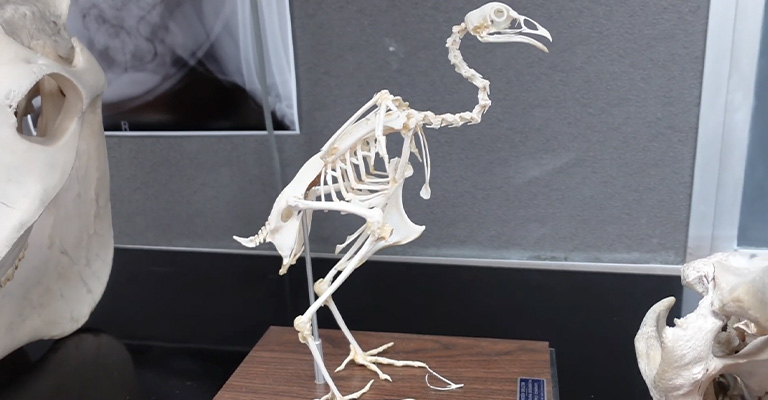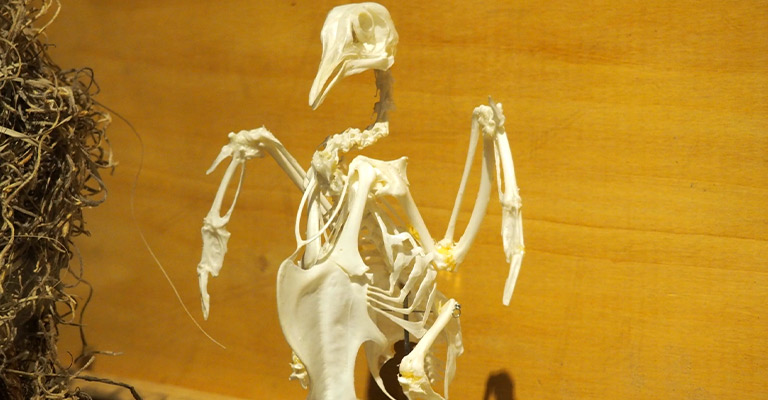One of the most striking features of birds is their lightweight and hollow bones. Unlike human bones, bones have no bone marrow inside.
So why do birds have hollow bones? Birds have hollow bones to provide a lightweight advantage for flight and also to strengthen them with a honeycomb-like structure.
The bones also serve as a respiratory aid by accommodating air sacs that regulate breathing.
Whether you’re a bird enthusiast or just curious about the natural world, this article will provide an in-depth look into the incredible adaptations of birds. Let’s dive in and learn it all.

What are Hollow Bones in Birds?
Birds have a lightweight skeletal structure that enables them to take off, fly and maneuver in the air efficiently. The bones in their wings and legs are hollow, reducing their weight without compromising strength.
The hollow spaces within the bones are called “medullary cavities,” and they are filled with a spongy, lightweight tissue called “cancellous bone”. This tissue provides structural support while also being much lighter than solid bone.
Additionally, the bones are reinforced with struts and cross-bracing, adding strength and stability while keeping the overall weight of the bone low.
The Evolution of Hollow Bones in Birds

The evolution of birds can be traced back to the dinosaurs, specifically a group known as theropod dinosaurs. These dinosaurs were bipedal, had feathers, and were likely capable of gliding or short flights.
Over time, these theropod dinosaurs evolved to become more efficient fliers, eventually leading to the birds we know today.
And one of the key adaptations that allowed birds to evolve into efficient fliers was the development of hollow bones. Hollow bones have a much lower density than solid bones, which makes them much lighter. This reduction in weight is crucial for birds, as it allows them to fly with less effort.
The Anatomy of Bird Bones
Source: http://www.paulnoll.com/Oregon/Birds/Avian-Skeleton.html
Bird bones are different from the bones of other animals in several ways. The most obvious difference is that bird bones are hollow. This is because birds have a unique type of bone structure known as pneumatization. Pneumatization is the process of creating air spaces within bones.
The air spaces in bird bones are connected to the bird’s respiratory system, which allows for the exchange of gases between the bones and the bird’s lungs. This is known as the “pneumatization of bones” or the “pneumatization of bone cavities”.
Likewise, the bones of birds also have a unique structure that allows them to be lightweight yet strong. Their bones are reinforced with layers of a strong, fibrous material called “cortex”. This cortex is surrounded by a thin layer of spongy bone, which provides additional support.
The Metabolic Benefits Of Hollow Bones
Hollow bones are a characteristic feature of birds and some other animals, such as bats. The hollow structure of these bones allows for several metabolic benefits, including
- Reduced weight and increased flight efficiency. Birds lift their own weight off the ground in order to fly, so a reduction in bone weight can greatly increase their ability to fly.
- Additionally, the hollow structure of the bones allows for the storage of air, which further reduces the overall weight of the animal. Birds have a unique respiratory system called the “unidirectional flow system,” which allows them to extract oxygen from the air more efficiently.
- Hollow bones also help to dissipate heat more efficiently. This is particularly important for birds that fly at high altitudes where the temperature can be very low. The hollow structure of the bones allows for air circulation, which helps dissipate heat.
The Limitations Of Hollow Bones
While the presence of these hollow spaces can provide several benefits for birds, there are also several limitations associated with hollow bones.
More Fragile
One limitation of hollow bones is that they are less strong and more prone to fractures than solid bones. This is because the thin layer of compact bone that surrounds the air spaces is not as dense or as strong as the solid bone found in other animals.
As a result, birds with hollow bones are at a greater risk of suffering fractures or other injuries if they collide with objects or fall from a height.
Not Ideal for the Protection of Internal Organs
Another limitation of hollow bones is that they do not provide as much protection for the internal organs as solid bones do. As the compact bone surrounding the air spaces is thin, it does not provide as much shielding for the organs as the thicker and denser bones found in other animals.
Consumes Energy
Additionally, the process of creating and maintaining the hollow bone structure is energetically costly for birds. Birds need to invest more energy to build and maintain the thin walls of the bone structure. Also, they need more oxygen to sustain the air sacs, which consume a significant amount of energy.
Frequently Asked Questions
Let’s see some common questions that are frequently asked.
Having hollow bones reduces the weight of birds, which makes it easier for them to fly. The reduction in weight allows them to generate enough lift to get off the ground and stay aloft.
Yes, all birds have hollow bones. This is a characteristic that is unique to birds and is thought to have evolved as an adaptation for flight.
Birds have a unique way of maintaining the strength of their hollow bones. They have a thick layer of compact bone surrounding the hollow space, which provides the necessary strength and support for the bird’s body.
Conclusion
I think the mystery of why birds have hollow bones has finally been uncovered. This adaptation is truly a marvel of nature, a combination of engineering and evolution that allows birds to dominate the skies.
And it’s not just limited to small birds, even the largest bird species, like the condor and the ostrich, have hollow bones. Next time you see a bird flying overhead, take a moment to appreciate the marvel of its hollow bones.